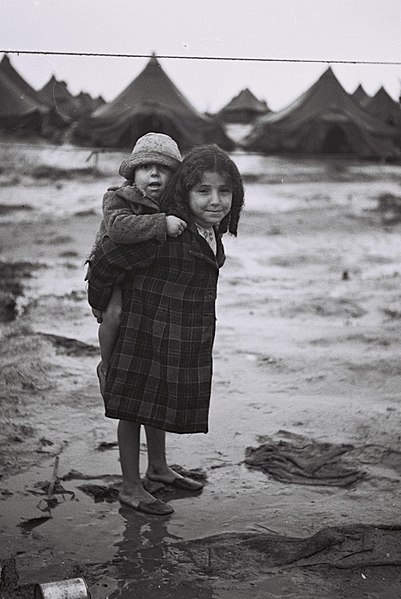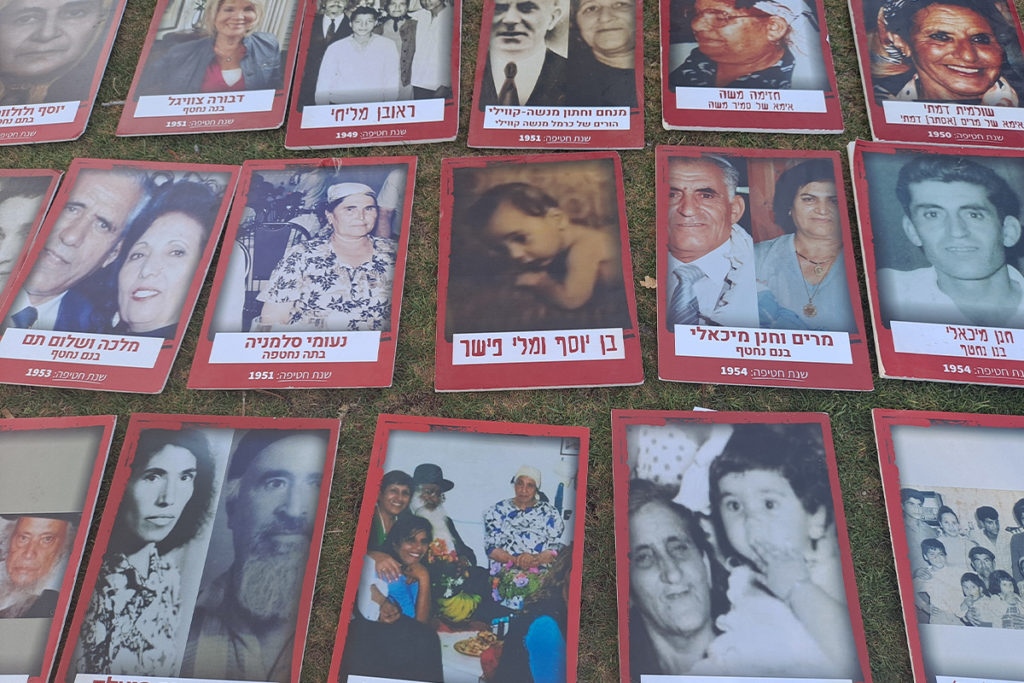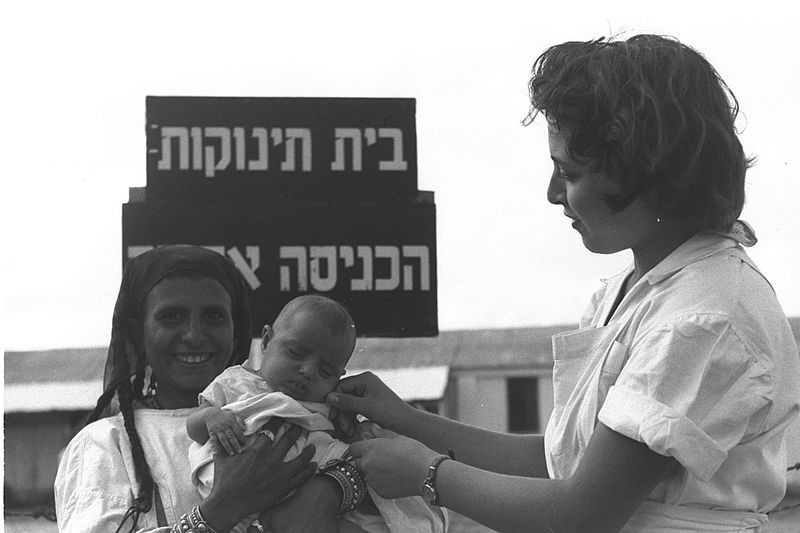The Yemenite Children Affair (Hebrew: פרשת ילדי תימן, romanized:
Parshat Yaldei Teiman) refers to the disappearance of mainly Yemenite Jewish babies and toddlers of immigrants to the newly founded state of Israel from 1948 to 1954. The number of affected ranges from 1,000 to 5,000.The majority of immigrants arriving in Israel during this period were from Yemen, with considerable numbers coming from Iraq, Morocco, Tunisia, Libya and the Balkans. According to low estimates, one in eight children of Yemenite families disappeared. Hundreds of documented statements made over the years by the parents of these infants allege that their children were removed from them. There have been allegations that no death certificates were issued, and that parents did not receive any information from Israeli and Jewish organizations as to what had happened to their infants.However, Yaacov Lozowick, Chief Archivist at the Israel State Archives, has documented records showing that while the fate of a small fraction of the "missing" children cannot be traced, in the overwhelming majority of cases the children died in hospital, were buried, and the families notified, although these illnesses, deaths, and family notifications were handled with enormous insensitivity.In Lozowick's opinion, "There was no crime, but there was a sin."
 |
A young Yemenite girl carrying her brother in the Beit Lid camp |
Widespread accusations continue that the infants were given or sold to childless Holocaust survivors in a covert systematic operation. Conclusions reached by three separate official commissions set up to investigate the issue unanimously found that the majority of the children were buried having died from diseases.
Israeli Prime Minister, Benjamin Netanyahu, described the issue as ‘an open wound that continues to bleed’ for the many families not knowing what happened to the children who disappeared
Context
The Yemenite community was well established in Ottoman and then British Mandate Palestine by the turn of the century. The State of Israel was created in 1948 and almost immediately began to receive refugees who included both several hundred thousand Holocaust survivors and Jews who had become refugees as a result of the Jewish exodus from Arab and Muslim countries, which resulted in about 700,000 new immigrants from the Muslim world.
 |
Jewish Agency representatives meeting Yemenite immigrants, upon arrival at Lod airport 1949 |
Consequently, the population of Israel rose from 800,000 to two million between 1948 and 1958. During this period, food, clothes, and furniture had to be rationed in what became known as the Austerity Period. Between 1948–1970, approximately 1,151,029 Jewish refugees relocated to Israel. Many arrived as penniless refugees and were housed in temporary camps known as ma'abarot; by 1952, over 200,000 immigrants were living in these tent cities.
Roughly 50,000 Yemenite Jews were brought to Israel in Operation On Wings of Eagles through a temporary camp in Aden.
Disappearances
Conditions in the maabarot (tent cities) were harsh. There was poor hygiene and widespread disease. The authorities decided it would be best to move the babies to separate (concrete-built) houses. Older children were often moved to a temporary care of foster families. Furthermore, children who caught an infectious disease had to be quarantined: moved to special wards in other hospitals. Hospital staff would often discourage contact between parents and children in fear of further spread of disease. Many babies did eventually die. And in those cases they were often buried in haste without waiting for the parents; due to poor communication it would often take days or more for the parents to be notified and come, and the hospitals did not have the resources to keep the bodies for that long.This resulted in many cases where information about children was lost.Many of the complaints have common characteristics:
|
|
Nurse with Yemenite mother and child at Ein Shemer kibbutz 1950 |
Almost all the missing children were under the age of 3, they were the children of new immigrants who were less than a year in Israel and who arrived at the newly founded country in the immigration waves of those years (see also Operation Magic Carpet), and almost all were descendants of Mizrahi Jews—especially descendants of immigrants from Yemen.
Almost all disappeared while in hospitals or when they were allegedly taken to hospitals.
Almost all the parents received only a spoken explanation that their children had died. The spoken message was only given to the parents when they inquired about the cause of their children's disappearance and in most instances they were told of their child's sudden death only after the funeral (or the alleged funeral) was held in their absence. In addition, the death records were incomplete.
Some of the parents of the children who disappeared received a recruitment order from the Israel Defense Forces at a time when their children were supposed to approach the age of recruitment.
The mystery surrounding the disappearance of these children has led to the claim that while many children were recorded as having died, in fact they were either kidnapped or were adopted by rich Ashkenazi Jews in Israel or abroad. The affair has been widely covered in the Israeli media through the decades, and so far four official investigating committees have been established to investigate the claims. The committees have investigated many hundreds of cases, and determined that the vast majority of children actually died and only in a minority cases they did not find enough evidence to determine what really happened.
The peak of the public outcry on the matter occurred in 1994 when Yemenite Rabbi Uzi Meshulam established an "armed sect" of radical Yemenite Jews in his garden, who barricaded themselves in his home and violently resisted Israeli law enforcement while demanding that the Israeli government establish a State Commission of Inquiry to examine the matter.[16] Meshulam's efforts led to the creation of the Kedmi Commission the following year. The third commission of its kind, it set out to reinvestigate the disappearances.
Inquiry committees
Since the 1960s, the Yemenite children affair has repeatedly been the subject of public debate every few years. As a result, through the years three formal inquiry committees and one public inquiry committee were established to investigate the matter and to expose the truth on this issue.
The Bahlul-Minkowski Committee
In 1967, the Bahlul-Minkowski Committee was established. After examining 342 cases of disappearances, the committee determined that in 316 of these cases it was confirmed that the children had died, and that in 2 instances the children were adopted; the other 24 cases were inconclusive.
Shalgi committee
The Israeli government led by Yitzhak Shamir established a commission headed by Justice Moshe Shalgi which lasted four years.This committee received new evidence on 301 children, and determined that in 65 of these cases their fate was unknown. It determined that in all the other cases the children did die.[20] The report was met with dissatisfaction by some Knesset members with David Mena saying, 'The report doesn't reflect the real picture of the Yemenite children's disappearance.' Knesset member and chair of the interior committee, Dov Shilanski, who had overseen testimony given said, ‘I personally believe, in contradiction to the Shalgi report, that there were more than a few cases of kidnapping of Yemenite babies.’
Kedmi Commission
In 1995, immediately after publication of the Shalgi Committee's conclusions, and following a public uproar, the Kedmi Commission was established.[19] Also known as the Cohen-Kedmi Commission, it was created in order to examine more than 1,000 cases of missing children.
In 2001, the commission published its conclusions. It found that in the state’s first 6 years, although as many as 5,000 children may have disappeared, there was no basis to the claim that the establishment abducted babies. Hundreds of thousands of documents relevant to testimonies and evidence were placed under lock for 70 years and will not be available to the public until 2071. The committee examined more than 800 cases, and did not manage to reach absolute conclusions in 56 of these cases. The committee determined that in 750 cases the children actually died. The commission said that about 50 children were unaccounted for.
Re-examination
In June 2016, Prime Minister Benjamin Netanyahu appointed Tzachi Hanegbi, a government minister, to re-examine the evidence in the three previous inquiries.Netanyahu said it would "right an historic wrong", and marked a new era of transparency. The government opened up nearly all of the archives of the inquiries putting them online.
Disturbing revelations followed in a special Knesset committee about medical experiments that had been conducted on the Yemenite children. Prior testimony given under oath during the previous inquiries revealed that many children had died as a consequence of medical negligence. Further testimony revealed that four undernourished babies died after being administered an experimental protein injection. Violating Jewish tradition, post-mortem examinations were carried out on children who were then buried in mass graves. Children's hearts were removed in some cases and given to US doctors researching the near absence of heart disease found in Yemen.
In the 1950s, Yemenite immigrant children were tested to determine whether they had a strain of sickle cell anemia in their blood (formerly thought to be associated strictly with “Negro blood,” but later determined to be a mutation of the blood cells to combat malaria).The methods used by the doctors hastened the deaths of some children.
Public admission
In 2016 after having re-examined evidence given to a commission of inquiry in the late 1990s, Cabinet Minister Tzachi Hanegbi told Israeli TV: "They took the children and gave them away. I don't know where." The minister admitted that at least "hundreds" of children were taken without their parent’s consent, marking the first time such a public admission had been made by a government official.
Events since
After the issue resurfaced, a Haaretz investigation found that dozens of Ashkenazi children vanished in a manner similar to the way the Yemenite children did.
On 23 January 2018, after staging a mass demonstration in Petach-Tikvah, Yemenite families of children believed to have been abducted were given permission by the State Attorney's Office to exhume 18 graves said to be those of their missing loved ones. Their hope is that, by exhuming their bodies for DNA testing, if the graves should prove to be empty or that the genetic findings do not match those of their siblings, it would give undisputed evidence of a cover-up in the disappearance of these children.
Official recognition and compensation
Against the background of a lawsuit by the families of Yemeni immigrants, in February 2021 the government approved a decision to "express sorrow" over the Jewish Yemeni children affair and the compensation of the families, and that the state "recognizes the suffering of the families". Families whose child's fate is unknown to them will receive up to NIS 200,000. Families who have not received real-time information about the death of their children - including the death itself, its circumstances or the place of burial - will receive NIS 150,000 each. Only families whose case has been tried in the committees of inquiry are entitled to compensation.


